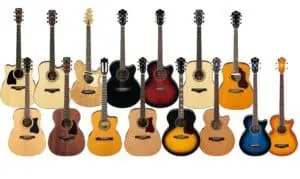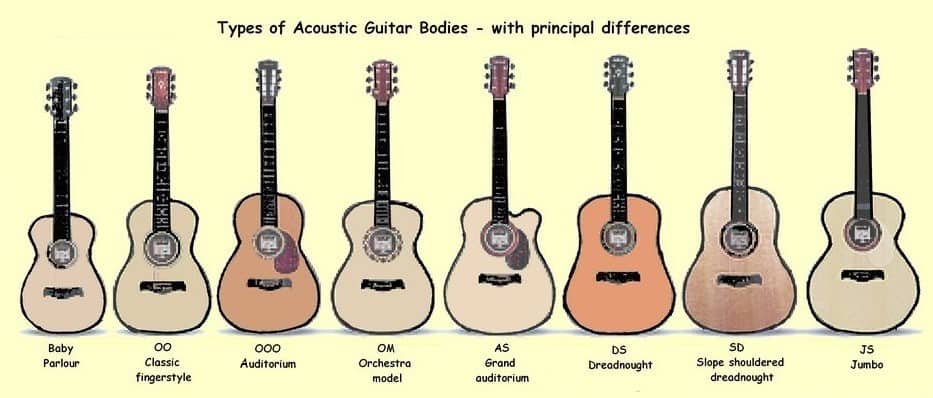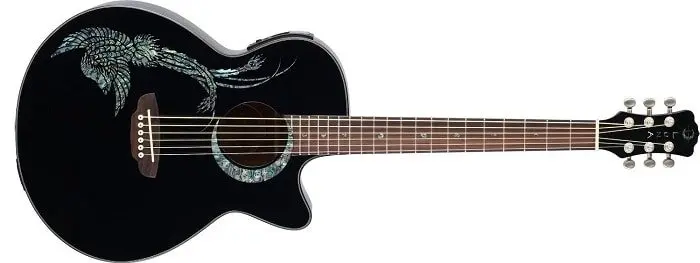 Guitars come in all kinds of shapes and sizes. This is not really that significant when it comes to electric guitars as they don’t require a soundbox in order to produce sound.
Guitars come in all kinds of shapes and sizes. This is not really that significant when it comes to electric guitars as they don’t require a soundbox in order to produce sound.
Sure, tonewood plays a part in the way a guitar will sound, but it’s only a limited factor. Acoustic and classical guitars have a completely different nature. The soundbox on these instruments is what produces sound, and the material the guitar is made of along with the size of the soundbox itself plays a huge when it comes to sound of that instrument.
Our goal today is to take a look at different guitar dimensions, sizes, and shapes in order to figure out how these factors affect the sound you will get from that guitar. We’ll look at some of the most popular sizes and shapes, and compare how they sound in relation to each other.
Dimensions

Guitar dimensions are something that has been standardized by now. There are some guitars that feature non standard dimensions, but those are fairly rare. We will stick to those guitar sizes that you are most likely going to encounter starting from the smallest one and moving up the scale.
[su_label type=”success”]Parlor and Travel Guitars[/su_label]
Parlor and travel guitars are the smallest type of guitars commonly offered on the market. This is a category where you will find ukeleles and guitaleles. These guitars were designed in a way that makes them convenient for traveling – hence the name – and for players of smaller stature to play. Travel guitars usually feature a 3/4 scale compared to full-size guitars, and have a tone that is rich in trebles while it lacks bass.
[su_label type=”success”]Concert and Grand Concert Guitars[/su_label]
Concert guitars are the smallest full-size guitars. Their lower bout is usually somewhere around 13-1/2 inches. They feature a full scale, and have a much fuller sound compared to travel guitars. You can expect great trebles and even better mids.
Low bass tones are still somewhat limited due to the size of the soundbox, however these guitars do offer some bass. Grand concert guitars slightly larger, usually an extra inch in the lower bout, and have pretty similar tonal properties with the addition of more volume in general.
[su_label type=”success”]Auditorium and Grand Auditorium Guitars[/su_label]
With auditorium guitars, we are already stepping into mid-size range of acoustic guitars. Auditorium style guitars feature a much larger lower bout that is usually around 16-inches, and a slim waist.
The overall design of the guitars offers the comfort you can find in concert guitars, but with a much improved sound. You can expect lots of volume, great bass response, and generally more balanced sound.
[su_label type=”success”]Dreadnaught Style Guitars[/su_label]
Dreadnought shape is the most recent body style of acoustic guitars. It was invented at the beginning of the 20th century, and has since became the most popular body type of acoustic guitars.
These guitars feature a large bout, about the same size as auditorium guitars, with a much wider waist, which makes them somewhat less comfortable to play. The sound properties of this shape are similar to those of auditorium guitars with the addition of extra volume and projection.
[su_label type=”success”]Jumbo[/su_label]
The largest standard body size of acoustic guitars is jumbo. The shape is similar to that of auditorium body style, but with a much larger lower bout. You are looking at 17-inches on average.
Jumbo guitars have a slim waist which gives them a distinct hourglass shape. These guitars resonate with great drive and definition. Bass tones are accentuated while trebles and mids project with a lot of power.
[su_label type=”success”]Cutaways[/su_label]
Acoustic guitars sometimes feature a cutaway, no matter which body style you look at. A cutaway is great because it allows the player to reach high notes on the fretboard, however it impacts the sound of the guitar in certain ways.
With that said, the difference is often times barely noticeable and many guitar players prefer to have a cutaway on their guitar simply because it makes the instrument more comfortable to play.
To conclude
Different body styles and guitar dimensions have different properties. Choosing an acoustic guitar depends on what you want that guitar to sound like, and what is comfortable for you to play.
The latter should be your main guideline when looking at different guitar sizes. If you can’t play the instrument comfortably, nothing else really matters.

